The Acropolis of Athens Old Museum
IntroductionThe Museum existing until lately on the Acropolis rock was considered among the most important ones in the world and definitely the most important one as far as the History of European Art is concerned. It was built on the Acropolis Hill in 1874, in such a way that it would not aesthetically interfere with the Temples, nor be visible from anywhere within the city of Athens.
The excavations that followed, toward the end of the 19th century, unearthed a wealth of finds which were impossible to exhibit in the limited space of the Museum. Thus, the inscriptions, bronzes, clay objects, and a variety of other items were kept in the National Archaeological Museum, where they were originally taken for conservation. The situation was aggravated after all the marble pieces were removed from the Parthenon Friezes (that is, what was left over after Elgin's plunder) and were put in the museum, together with the Caryatids (the marble statues of the women supporting the roof of the south porch of the Erechtheion), all of which were removed to be kept in an air-tight window containing nitrogen, so as to stop air pollution from deteriorating the marble surfaces.
The collections of the museum included:
Sculptural offerings of the Archaic period
Pediments of temples dated to the Archaic period
Archaic Horsemen
Sculptures of the "Severe" style
Pediments and metopes from the Parthenon
The Parthenon frieze
The Erechtheion frieze
Parapets of the Athena Nike temple
Frieze of the Athena Nike temple
The Caryatids
Clay figurines and vases from the sanctuary of the Nymphs.
Everyone was eagerly anticipating the completion of the new Acropolis Museum, for the total wealth of finds related to the Acropolis and the Parthenon to finally be exhibited in the best possible way (combining location, lighting, space, air filtering and thematic consistency), and thus deprive the descendants of Lord Elgin of all plausible excuses to insist that the Parthenon Marbles continue to be kept separated from the rest of their like and the Parthenon remain in its mutilated state.
During 2008, the exhibits of this Museun were transferred to the New Museum, the erection of which was completed. Three huge cranes were used to carry all the heavy marble statues and exhibits, a total of some 4,500 artifacts from the old, cramped Acropolis museum, a task that was the biggest airlift of antiquities in Greek history. It was the first time the artifacts — some of which are considered among the most important works of antiquity — were moved from the very Acropolis Rock. This transfer was completed in the end of spring but putting up the exhibits in their right place would take a lot longer.
We thought that the present Album would become useless after the New Museum's inauguration. Nevertheless, the decision of the museum authorities to prohibit taking photographs of the exhibits in their new surrounding created more problems than the ones it was supposed to solve. We admit that the decision was well meant, but, with all due respect, we would like to point out that times have changed; we are afraid that whatever is not shown online cannot achieve the level of promotion that it may be worthy of. We managed, though, to get a number of photos of the exhibits, as the decision was taken a couple of weeks after the museum's inauguration. We are working on them and will do our best to put them up as soon as possible. But, in our effort to best present the exhibits, we are sorry to have to use some of the photos taken at the Old Acropolis Museum. Until the New Acropolis Museum album is online, please enjoy the marvellous artifacts at their old "home".
(Photos: Michael Tziotis)
Select Page of the Album:
Click on any of the pictures to enlarge.
Gallery VIISculptures from the decoration of the Parthenon (444 - 432 BC), Metope 12 from the south side with a Centaur and a Lapith woman. The group of Kekrops, the torso of Poseidon, Illissos and Kallirhoe, from the west pediment. Hephaistos and the torso of Selene from the east pediment and small models with reconstructions of the pediments.
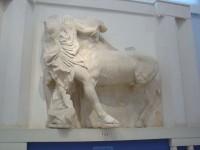
Akr 705. Centaur Seizing a Lapith Woman from the Twelfth “Metope” on the Parthenon South Side
A sculpture depicting a centaur seizing a Lapith woman. In her struggle to escape his clutches she suddenly twists her body, causing her “peplos” to slip down bearing her breast and right leg. |
|
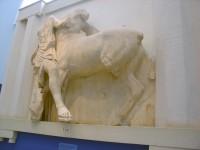
Akr 705. Centaur Seizing a Lapith Woman |
|
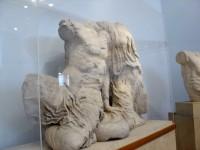
Akr 14935. Kekrops and Pandrossos
A two-figure group identified as the legendary king Kekrops and one of his daughters, perhaps Pandrossos. Kekrops is seated with “himation” wrapped around the lower part of his body, ending to a snake’s tail. His daughter has her arm around his shoulders. |
|
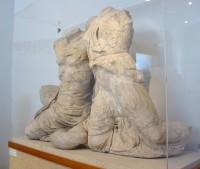
Akr 14935. Kekrops and Pandrossos |
|

East Pediment of the Parthenon
The sculptures belonging to the center of this pediment were destroyed when the Parthenon was converted into a Christian church by building an apse at the east end. We know the pediment showed the birth of Athena, who sprang fully grown and armed from the head of her father Zeus, after Hephaistos struck him with an axe. The center piece must have comprised these three and, probably, Hera. The surviving sculptures are of other gods witnessing this event, and of horses drawing the chariots of the Sun (far left) and Selene (Moon) (far right). The reproduction in this picture is only one of the many suggested at various times by researchers. |
|
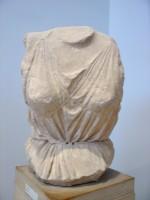
Akr 881. Torso of Selene (The Moon) from the Right Corner of the Parthenon East Pediment
Please notice the two holes indicating the place of the belt buckle. |
|
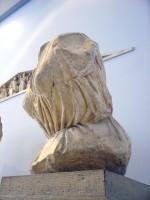
Akr 881. Torso of Selene (The Moon) from the Right Corner of the Parthenon East Pediment
It is her profile from the right. It must be noted that, because of the positioning of the statue to the pediment's right and its orientation to the left, this was the side of the sculpture not visible to the ancient visitors of the temple, yet elaborately worked with the same craftmanship as the rest of the sculptures! |
|

West Pediment of the Parthenon
The reconstruction shows how the sculptures might have appeared when completed in about 433 BC. The center part was a great cross of two gods, Athena and Poseidon, with rearing chariots and charioteers and attendant deities behind mirroring and supporting the duel. Beyond them matters are calmer and less symmetrical with reclining and kneeling figures of both sexes and all ages attending, rather than watching, the outcome of the struggle; they are probably early kings and heroes of Attica and their families. The reproduction in this picture is only one of the many suggested at various times by researchers. |
|
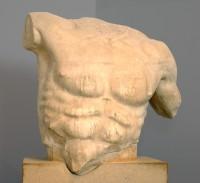
Akr 885. The torso of Poseidon from the west pediment.
The god is raising his right arm; he must have held the trident in his right hand. The body with the detailed rendering of the musculature seems to draw breath, swelling with life and energy. The lower part of the chest is a plaster cast of the original in London. |
|
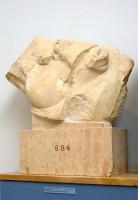
Akr 884. Part of Horse-head from the West Parthenon Pediment |
|
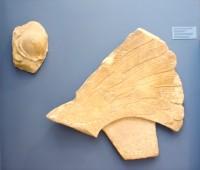
Akr 1233. Fragment of a breast from a female pedimental figure And Akr 996. Part of a wing from a pedimental sculpture |
|
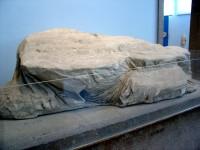
Akr 14936. Fragment Of Kallirhoe
Fragment of a reclining female figure from the southern corner of the west pediment, right beside figure Akr 887. She is identified as Kallirhoe, the personification of the Athenian spring of the same name. |
|
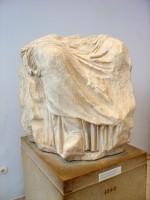
Akr 1363. |
|
|
Select Page of the Album:
|
|



